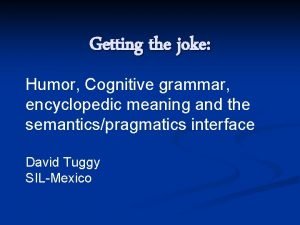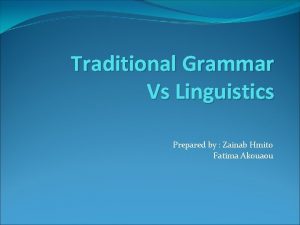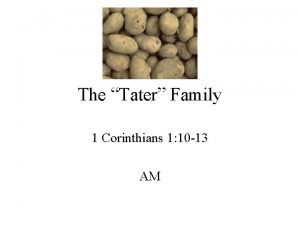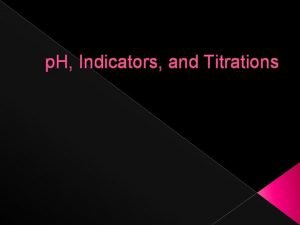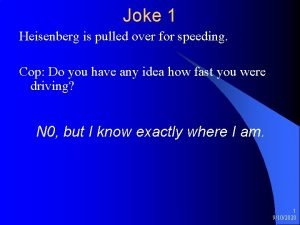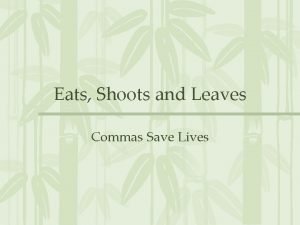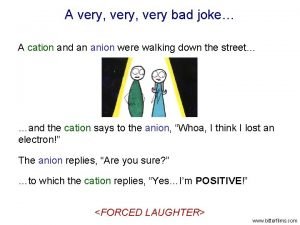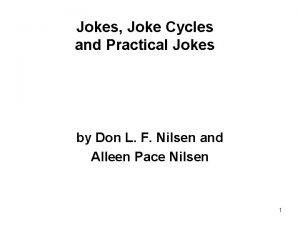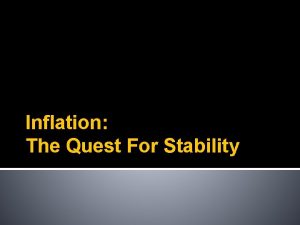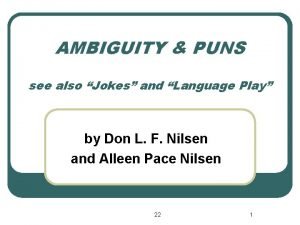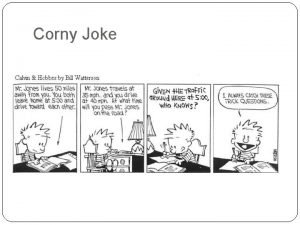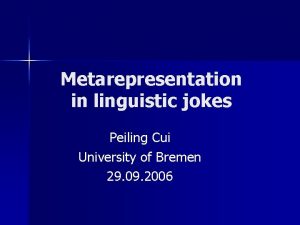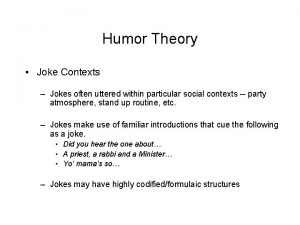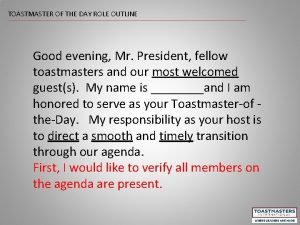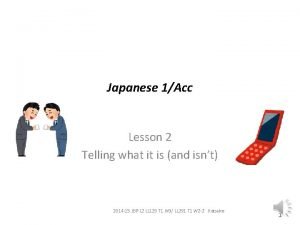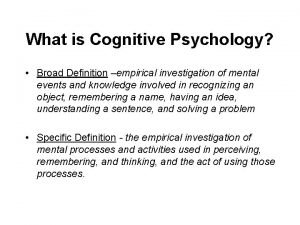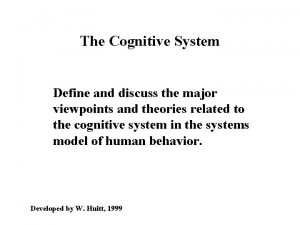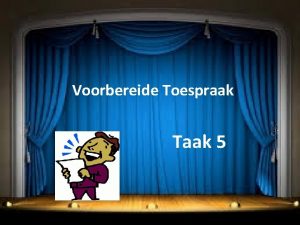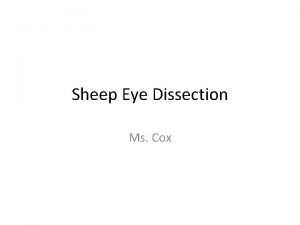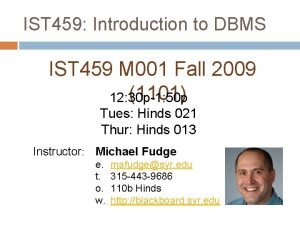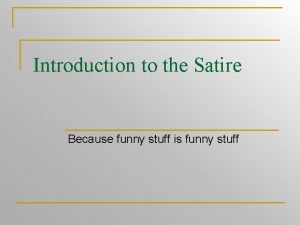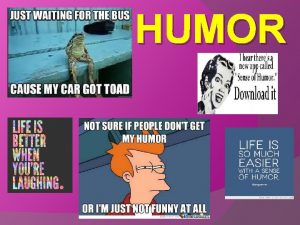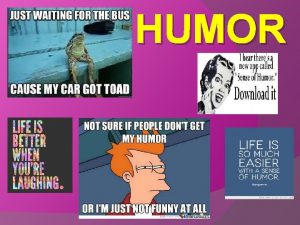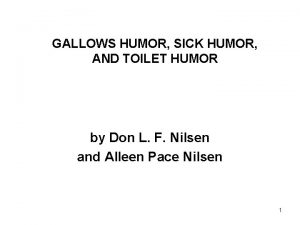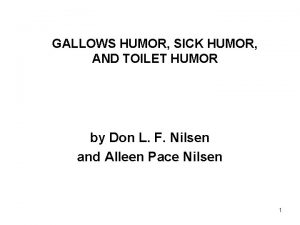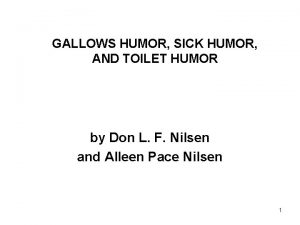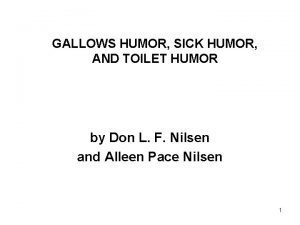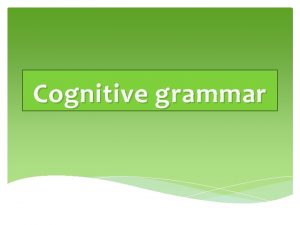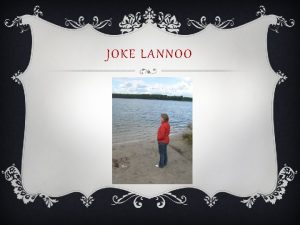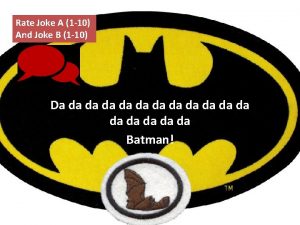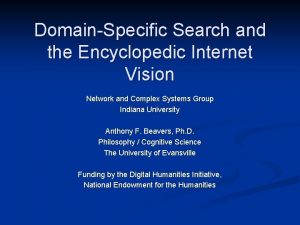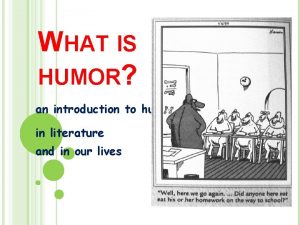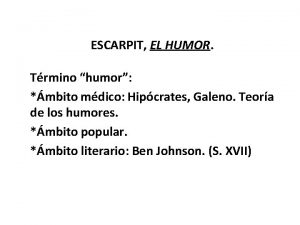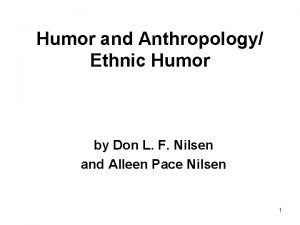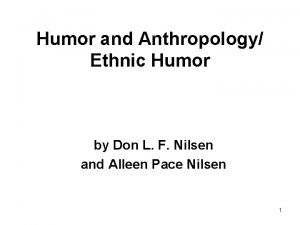Getting the joke Humor Cognitive grammar encyclopedic meaning


























































































- Slides: 90

Getting the joke: Humor, Cognitive grammar, encyclopedic meaning and the semantics/pragmatics interface David Tuggy SIL-Mexico

“Existence proofs” from humor Humor often involves somewhat extreme uses of language. n This makes certain aspects of the nature of meaning more obvious or difficult to ignore. n Many jokes use “indirection. ” n I. e. , the speaker purposefully avoids mentioning crucial meaning, because it is funnier if people “tumble to” that meaning themselves. n Such jokes give an “existence proof” for encyclopedic meaning. n

E. g. The Chicken Joke n The animals are arguing over which one is the biggest, baddest and scariest of them all. n “I just growl, and all the animals in the forest scurry out of my way. ”

The Chicken Joke n “I roar, and the whole savannah trembles with fear. ”

The Chicken Joke n “Ha, that’s nothing. All I do is cough, and the whole world freaks out!”

“Existence proofs” from humor n Meaning evoked by chicken includes (though it is never mentioned explicitly) BIRD FLU. n Meaning evoked by cough includes BIRD FLU as well. Unless you get the connection to BIRD FLU you don’t get the joke. n

“Existence proofs” from humor n Of course BIRD FLU is not a central specification of either chicken or cough.

“Existence proofs” from humor n But any theory of meaning that does not allow for the existence and availability of such peripheral meanings has to be wrong.

Not why, but how is it funny? At issue here is not why (or if, or to what degree) a joke like the chicken joke is funny. n We will concentrate on how it is funny, i. e. what does it take to get the joke. n You can get the joke and not find it funny, of course. n But if you don’t get the joke and still find it funny, you are in fact laughing at a different joke. n

Still … Note how much less funny the chicken joke would be if the chicken said “People are so afraid of bird flu that when I cough they think I have it and they freak out. ” n Skillful indirection is among the things we find funny, thus a good ingredient for jokes. n

Language and Culture-bound humor Clearly much humor is culture-bound. n Some is, in addition, language-bound n n ∃ puns and other form-based word-play. You expect that to be language-bound.

Language and Culture-bound humor n Much meaning-based humor is still language- and/or culturebound. n The chicken joke is fairly translatable (e. g. to Spanish or Russian) and “works” in those modern cultures. n (Though it worked better a couple of years ago!) You could not expect it to work in the Yanomamo or Sumerian cultures. n If they heard it and thought it funny, it would quite certainly be because of other connections. n It would be a different joke, in fact. n

What does it take to “get the joke”? (Traditionally) Meaning = semantics + pragmatics. n Much humor plays around on the pragmatics/semantics interface. n Semantics is largely culture-specific. Many assume pragmatics is not. n Cognitive Grammar (= CG, Langacker 1987, 1991, 2004) has, I think, some interesting things to say in this regard. n

Inclusion = Connection (the Container metaphor) Under CG, meanings consist of cognitive (mental) structures activated through (associative) mental linkages. n Representing such linked structures as “contents” via the “Container Metaphor” is not illegitimate, but it must not be pressed to hard. n

Inclusion = Connection (the Container metaphor) n We used oval “shells” in the diagram to represent BIRD FLU as “included” in the meanings of chicken and cough. These, like the phrase “the meaning”, are highlevel reifications.

Inclusion = Connection (the Container metaphor) n n n In fact, the “concepts” we connect turn out, when examined, to be collections of connections. Thus when we “shell” them that also is a reification. They are notational variants of systems of linkages.

Central/Peripheral meanings n The difference between central and peripheral specifications is a matter of n n How likely it is (to the point of inevitability) that a specification gets activated. How strongly it (usually) gets activated

Central / peripheral meanings n n Such collections of central and peripheral meanings constitute “encyclopedic meaning”. CG, from the beginning, insisted on the legitimacy and importance of encyclopedic meaning.

What is the difference between Semantics and Pragmatics? n CG says that to be part of a language, meanings (or other cognitive structures) must be not just n Common: shared by the relevant people (esp. interlocutors in a communication situation) but also n Conventional(ized): Established as common by usage.

What is the difference between Semantics and Pragmatics? I will take conventionality/conventionalization as a major difference between Semantics and Pragmatics n Conventionality is clearly a matter of degree, not a plus-or-minus issue n

A continuum, not a dichotomy n We will use a color gradation to represent this. n Yellow = (strongly) established, light blue = not yet established, light green = in between

What is the difference between Semantics and Pragmatics? Semantic structures are conventionalized. n Pragmatic structures are not (yet), n But they often are common n And if they are not at first, they become so during the communication process. n

Constructed meanings n n n Many larger-scale meanings are also not yet conventionalized, but are not usually considered pragmatic. These are constructed meanings. For instance, in the Chicken joke, the idea of a chicken coughing is clearly meant. But this notion is not a pre-established part of English for most users not familiar with the joke. It is constructed through the combination of lexical items and syntactic patterns used.

Constructed meanings and blending n Although it is fairly closely controlled, it involves a degree of “blending”, and is not entirely predictable.

Constructed meanings and blending n This blended, constructed meaning strongly activates the concept BIRD FLU.

What is the difference between Semantics and Pragmatics? n n As the “mental leaps” needed to achieve the proper blend become less and less overtly constrained, people tend to talk of pragmatic “inferences”. Again, the difference between them and constructed meanings is one of degree—degree of coercion or control over what meanings are to be achieved. n n With semantic or constructed meanings you tell people what to think of. With pragmatic meanings you hope they will think of the right thing.

Deictic Pragmatic concepts Some pragmatic structures I will call “deictic pragmatic”. n They consist of concepts that are common to the interlocutors from the immediate context of speech, which have not yet been conventionalized by usage. n

Deictic Pragmatic concepts IThis purposely did us notto identify allowed mention bear and who wasthespeaking. the lion by name, but n But it didn’t tell you showing their pictures linguistically made the salientwho it was. of thempragmatic n concept Most deictic common as a less conceptstoareus even group. coercive. n n

Different kinds of meanings

Different kinds of meanings n The categories fade or blend into each other.

From common to conventional n The meanings we are talking about are common, if not conventional, by the end of the conversation. n n We’ll see later an example of meaning that doesn’t become common. It’s worth talking about too. Communication is commonication: The whole point of it is to make information (meaning) common. Communication is usage that establishes commonality. It is thus *automatically* and *inevitably* a step towards conventionalization (i. e. towards being established by usage. )

Semantic or pragmatic connections? n n n As we saw already, jokes often involve connections through encyclopedic meaning. Is that encyclopedic meaning semantic, or pragmatic? Or constructed? or what? Typically, it is a mixture.

The Chicken Joke (again) n n Is the concept BIRD FLU semantic (conventional, established by usage)? n n There are two questions here: Yes, clearly. Are the connections to it from chicken and from cough semantic?

The Chicken joke n The connection from chicken to BIRD FLU is certainly semantic. n n We have all heard (usage) that chickens carry it, and that where it is found flocks of chickens are killed to stop it. It is (even) not uncommon for it to be called chicken flu.

The Chicken joke n n The (resultative/symptomatic) connection from cough to FLU is also certainly semantic. So too the (elaborative) connection from FLU to BIRD FLU.

The Chicken joke n n However, the combination of these two links is probably not semantic for most speakers. I. e. , most of us have not heard usage linking coughing with BIRD FLU.

The Chicken joke n This is, in fact, a (relatively mild) example of pragmatic inferencing.

The Chicken joke n Overall, then, we can consider that the linkage is pragmatic, even though it is composed of a combination of (pre-established) semantic links.

The Chicken joke n n This is so common as to be typical of pragmatic connections: they are composed largely of pre-established, semantic links, combined in a novel way.

n Constructed meanings and blending The connection from the constructed chicken…cough to BIRD FLU is, as previously represented, nonestablished, and pragmatic.

Constructed meanings and blending n The connection from the constructed the whole world freaks out to the notion of world-wide fear and panic over bird-flu, is also nonestablished.

n n What it enhances, namely the notion of widespread fear connected to BIRD FLU, is semantic, already part of BIRD FLU. This (again) enhances the whole notion of BIRD FLU, making it clear that is what is really being talked about. Constructed meanings and blending

The Chicken joke (Somewhat incidentally: ) n Note the usage of the (in the purely linguistic version of this joke). It is significant and typical for many jokes: n n The bear, the lion, and the chicken are marked as stereotypical participants in a conventional “script”. n (also as representatives of their species) n This “script” (which helps make this joke work/be easy to understand) is a schematic construction defining this type of joke:

The Chicken joke n In the script n n n several agonists (typically three) vie for some sort of supremacy the first ones (typically two) establish a trend for the manner of demonstrating supremacy the last one (the eschatagonist? ) violates that trend and establishes supremacy in an unexpected way it may in fact be surprising (as in this case) that the eschatagonist is a participant at all In a language which lacks this script, the joke will probably not work as well.

The next joke was told by a friend of mine. n I will first give you the punch line, then supply some context. n

The Beard Joke n “You can tell which end of his face he uses the most. ”

The Beard Joke This is a rather widely translatable joke (English, Spanish, Nahuatl, others? ) n That is because the metonymic connections involved, though actually quite complex, are established (semantic) in many cultures. n I’ve tried to represent some of these in the following diagram n

The Beard Joke n Once you’ve gotten to the point where the opposition THINK/TALK is strongly activated, you have pretty much understood the joke.

The Beard Joke n My friend was saying, in essence, “David talks more than he thinks. ”

The Beard Joke n Note how pragmatic and semantic connections are interwoven with each other logically (and presumably temporally to some extent. )

The Beard Joke n It would not work at all well to try to do all the semantics first, then all the pragmatics, or v. v.

The Beard Joke n There’s enough common semantic material in most languages that the pragmatic connections (deictic & inferential) can be trusted to go on similar lines.

The Beard Joke n That’s what makes the joke so translatable.

The Beard Joke n Of course, it may not be *funny* in all cultures, even if they *get* it. (e. g. maybe a serious insult)

The Beard Joke If you’ve seen the picture before you hear the joke, and noted the relevant details, the picture is giving you Deictic Pragmatic information. n But it also works seeing the picture later (as I showed it to you. ) n Or you might see it first, but notice the relevant details later. n

The Beard Joke If you hear someone tell the story, describing the essence of the picture (more normal joke format) — then it’s semantic. n (In the original context, someone had commented on my beard being whiter than my head hair. ) n Many of the connections would still be pragmatic, however. n

The Beard Joke Bottom line: n It doesn’t really matter whether the information is pragmatic or semantic, as long as it’s common, readily/already activated when the punch line comes. n

The Beard Joke Finally, it isn’t clear that there is any special joke script (schema) at work in this case. n It is relevant to the joke’s translatability that no such script is necessary. n

The Pigeon Joke Some days you’re the pigeon, n and some days you’re the statue. n

The Pigeon joke n Usage of the is similar to that of the Chicken joke: it marks the pigeon and the statue as fulfilling stereotypical roles in a script.

The Pigeon joke n The setting for that script is probably in a park (where you are likely to find pigeons and statues together).

The Pigeon joke n Crucially, the blended conception has the pigeon flying over and dropping excrement on the statue.

The Pigeon joke n Like the Beard joke, this is not clearly dependent on a particular joke-construction schema [though it certainly makes effective use of a more general syntactic schema some(TIME)s X, (and) some(TIME)s Y].

The Pigeon joke It is probably reasonably widely translatable where ∃ parks with pigeons and statues. n But not (in my experience) as effective/easy to get in Spanish as in English. n This is probably because the crucial link is more conventional in English than in Spanish. n

The Pigeon joke I have heard many more (conventional) complaints about bird droppings (e. g. on cars) in English than in Spanish. n ∃ widespread knowledge of the couplet Birdie, birdie in the sky, How I’m glad that cows don’t fly. n

The Pigeon joke n There is widespread knowledge of cartoons like the following (e. g. in The Far Side): picture © 2007 Christopher Tuggy

The Pigeon joke n n Thus the connection from pigeon/BIRD, especially in a joking context, to the idea of its droppings falling on something, is semantic (strongly preestablished) in English It is much less so in Spanish.

The Pigeon joke n The joke also involves a proverb-like abstraction permitting respecialization

The Pigeon joke Some days you subject others to disagreeable/disgusting/irritating /even insulting (but not terribly harmful) behavior, n and some days they do it to you n

The Blonde joke n Q: Why do blondes wear pony tails? n A: To hide the valve stem. n (Permission granted by Holly Tuggy)

The Blonde joke This joke is pretty culture specific; not widely translatable. n Indeed not all English speakers get it. n It is dependent on the constructional schemas for: n Q/A jokes n Blonde jokes, esp. the “dumb blonde” stereotype. n n Note (again) the usage of stereotyping the: the valve stem implies “every blonde has one”

The Blonde joke n It helps (almost: you need) to know & understand the idiomatic word airhead, strongly evoked by stereotypical blonde.

The Blonde joke n n Many English speakers don’t have a clear, immediately accessible meaning for “valve stem”. Some eventually remember or figure it out and thus get the joke, but it’s harder for them.

The Blonde joke n Those who get the joke get a strong blended picture of the blonde with the valve stem hidden in her ponytail.

The Blonde joke n This is not a pre-established concept of English. n Rather it is constructed on-the-fly.

The Blonde joke n But it is constructed (fairly strongly coerced) meaning: the joke in essence tells you that blondes have valve stems hidden in their pony tails. n Even those who don’t know what a valve stem is get this much.

The Blonde joke But there are less closely controlled (inferential) aspects to it as well. n Many construe the blonde’s head as the inflatable chamber. n

The Blonde joke n The crucial (pragmatic) connection in this case is from the indirectly evoked notion AIRHEAD.

The Blonde joke n Some get another meaning: the blonde’s whole body is the inflatable chamber

The Blonde joke n In this case the crucial connection is from the indirectly evoked notion INFLATABLE DOLL.

The Blonde joke That’s a somewhat different joke; calling blondes airheads is different from calling them inflatable dolls. n The constructed meaning does not control which construal you get. n

The Blonde joke n Many (myself included) get an off-the-wall picture of the air in airheads’ heads as under pressure, and as needing the pressure constantly monitored and adjusted.

The Blonde joke But others do not get that strongly. n Again, the constructed meaning does not control this. n It is all in the realm of pragmatic inferencing. n It may not even be common between the joke-teller and hearer. n

Recap/final points n n n Indirection, i. e. (purposeful) activation of unnamed concepts through peripheral meaning specifications, is a crucial ingredient in some kinds of humor. The distinction between central and peripheral specifications is important to conceive of properly, and to bear in mind. It is useful to distinguish semantic from pragmatic meaning by the parameter of conventionalization: semantics is conventionalized meaning, and pragmatic meanings are not (yet) conventionalized.

Recap/final points n Some pragmatic meanings are already common, though yet not established by usage. n n These deictic pragmatic meanings are like semantic meanings in being pre-available. Other pragmatic meanings are inferential connections that the hearer must (or may) make between activated meanings of whatever sort.

Recap/final points n Constructed meanings are also not pre-established. They are like pragmatic inferences in that they require a hearer to make new connections. n But they differ in being more closely controlled via schematic constructions. n

Recap/final points Pragmatic meanings, semantic and constructed meanings grade into each other, and are likely to be inextricably interleaved in particular meanings such as the meanings of particular jokes. n Much that may seem pragmatic is actually at least in some degree semantic (pre-established by usage. ) n If certain concepts or connections are not semantic for you as hearer, it may be harder for you to get the joke. n

Recap/final points However, as long as you get the joke, it doesn’t much matter if particular concepts or connections are pragmatic or semantic. n Understanding the subtleties of these sorts of connections helps us to understand why humor tends so strongly to be language- or culture-bound. n

Recap/final comments It is a very beautiful thing that so many people get these quite intricate and complex connections so reliably and so fast (well under 1 second). n Jokes work: people get them. And that tells us a lot about language. n

Powerpoint available at: www. sil. org/~tuggyd .
 Encyclopedic knowledge meaning
Encyclopedic knowledge meaning Humor vitreo
Humor vitreo Getting ahead
Getting ahead Cognitive and non cognitive religious language
Cognitive and non cognitive religious language The joke
The joke Cognitive grammar
Cognitive grammar Verbal irony in arsenic and old lace
Verbal irony in arsenic and old lace Left linear grammar to right linear grammar
Left linear grammar to right linear grammar Advantages of traditional grammar
Advantages of traditional grammar Unrestricted grammar example
Unrestricted grammar example Right linear grammar
Right linear grammar The tater family
The tater family What is this??
What is this?? Joke klaassen
Joke klaassen Heisenberg joke speeding
Heisenberg joke speeding Save the comma
Save the comma Macromolecules poem
Macromolecules poem Anion joke
Anion joke Joke cycles
Joke cycles Joke cycles
Joke cycles Inflation
Inflation Polish joke
Polish joke Covalent bond joke
Covalent bond joke Ionic bond joke
Ionic bond joke Syntactic ambiguity jokes
Syntactic ambiguity jokes Eu comecei uma piada que fez o mundo inteiro chorar
Eu comecei uma piada que fez o mundo inteiro chorar Systems of equations joke
Systems of equations joke Van deemter pronunciation
Van deemter pronunciation Codominance definition
Codominance definition Dokter deschutter annelies
Dokter deschutter annelies Cloud computing jokes
Cloud computing jokes Alzheimers eye test joke
Alzheimers eye test joke Paralympics joke
Paralympics joke Virtual reality joke
Virtual reality joke Java factory factory joke
Java factory factory joke Sexual harassment poster
Sexual harassment poster Stoichiometry joke
Stoichiometry joke Cell membrane joke
Cell membrane joke Scalar humor
Scalar humor Joke master role toastmasters
Joke master role toastmasters Denwa bango
Denwa bango Attention psychology definition
Attention psychology definition Cognitive systems definition
Cognitive systems definition Cognitive flexibility definition
Cognitive flexibility definition Hát kết hợp bộ gõ cơ thể
Hát kết hợp bộ gõ cơ thể Ng-html
Ng-html Bổ thể
Bổ thể Tỉ lệ cơ thể trẻ em
Tỉ lệ cơ thể trẻ em Voi kéo gỗ như thế nào
Voi kéo gỗ như thế nào Tư thế worm breton là gì
Tư thế worm breton là gì Bài hát chúa yêu trần thế alleluia
Bài hát chúa yêu trần thế alleluia Các môn thể thao bắt đầu bằng từ đua
Các môn thể thao bắt đầu bằng từ đua Thế nào là hệ số cao nhất
Thế nào là hệ số cao nhất Các châu lục và đại dương trên thế giới
Các châu lục và đại dương trên thế giới Công thức tính độ biến thiên đông lượng
Công thức tính độ biến thiên đông lượng Trời xanh đây là của chúng ta thể thơ
Trời xanh đây là của chúng ta thể thơ Mật thư anh em như thể tay chân
Mật thư anh em như thể tay chân 101012 bằng
101012 bằng Phản ứng thế ankan
Phản ứng thế ankan Các châu lục và đại dương trên thế giới
Các châu lục và đại dương trên thế giới Thể thơ truyền thống
Thể thơ truyền thống Quá trình desamine hóa có thể tạo ra
Quá trình desamine hóa có thể tạo ra Một số thể thơ truyền thống
Một số thể thơ truyền thống Cái miệng bé xinh thế chỉ nói điều hay thôi
Cái miệng bé xinh thế chỉ nói điều hay thôi Vẽ hình chiếu vuông góc của vật thể sau
Vẽ hình chiếu vuông góc của vật thể sau Biện pháp chống mỏi cơ
Biện pháp chống mỏi cơ đặc điểm cơ thể của người tối cổ
đặc điểm cơ thể của người tối cổ V. c c
V. c c Vẽ hình chiếu đứng bằng cạnh của vật thể
Vẽ hình chiếu đứng bằng cạnh của vật thể Fecboak
Fecboak Thẻ vin
Thẻ vin đại từ thay thế
đại từ thay thế điện thế nghỉ
điện thế nghỉ Tư thế ngồi viết
Tư thế ngồi viết Diễn thế sinh thái là
Diễn thế sinh thái là Dạng đột biến một nhiễm là
Dạng đột biến một nhiễm là Số nguyên tố là gì
Số nguyên tố là gì Tư thế ngồi viết
Tư thế ngồi viết Lời thề hippocrates
Lời thề hippocrates Thiếu nhi thế giới liên hoan
Thiếu nhi thế giới liên hoan ưu thế lai là gì
ưu thế lai là gì Hổ sinh sản vào mùa nào
Hổ sinh sản vào mùa nào Khi nào hổ con có thể sống độc lập
Khi nào hổ con có thể sống độc lập Hệ hô hấp
Hệ hô hấp Từ ngữ thể hiện lòng nhân hậu
Từ ngữ thể hiện lòng nhân hậu Thế nào là mạng điện lắp đặt kiểu nổi
Thế nào là mạng điện lắp đặt kiểu nổi Natuurbewaring toespraak
Natuurbewaring toespraak Non verbal humor
Non verbal humor Texture of sheep lens
Texture of sheep lens Database humor
Database humor Invective satire
Invective satire




